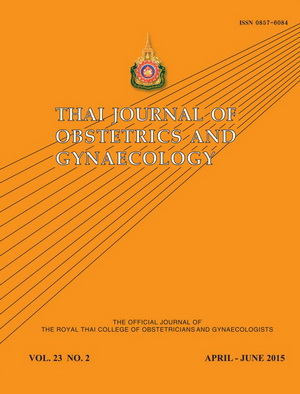Risk Factors of Emergency Peripartum Hysterectomy
Main Article Content
Abstract
Objective: To evaluate the incidence and risk factors of emergency peripartum hysterectomy.
Materials and Methods: A case-control study was conducted in the pregnant women who delivered at Ramathibodi Hospital, Bangkok, Thailand during January 2002 - December 2013. The study cases refer to pregnant women with gestational age ≥ 28 weeks who underwent emergency peripartum hysterectomy following cesarean or vaginal delivery. The control cases refer to pregnant women who delivered before and after the study cases by matching time and route of delivery. The medical records were collected and analysed. Multivariate logistic regression analysis was used to identify independent risk factors and the related adjusted odds ratios (aOR) and 95% confidence intervals (95% CI).
Results: During the study period, there were 64 cases of emergency peripartum hysterectomy out of 48, 970 deliveries (1.31:1,000 deliveries). In the completed data 60 cases, the indications for surgery were uterine atony 29 cases (48.3%) and placental factors 31 cases (51.7%). The placental factors included placenta accrete syndromes with placenta previa 15 cases (25%), placenta previa 9 cases (15%), placenta accrete syndromes 5 cases (8.3%) and abruptio placenta 2 cases (3.3%). According to multivariate analysis, independent risk factors were uterine atony (aOR = 170.7, 95% CI 42.1-692.7), placental factors (aOR = 130, 95% CI 33.1–516.2), birth weight ≥ 4,000 gm (aOR = 12.4, 95% CI 1.6-93.7).
Conclusion: The incidence of emergency peripartum hysterectomy was 1.31: 1,000 deliveries. Uterine atony, placental factors, and birth weight ≥ 4,000 gm were significant risk factors.

